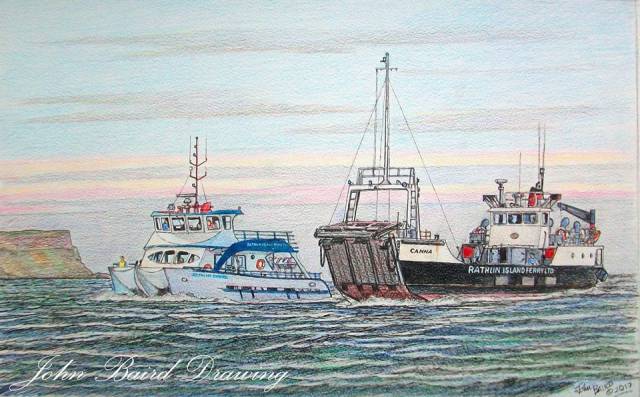#FerriesInArt – A beautiful art work depicting the current pair of Rathlin Island serving ferries will be a lovely keepsake for the operator as one of the vessels is soon to be replaced by a newbuild, writes Jehan Ashmore.
The colour sketched drawing show the ferries underway off Fair Head on the stunning Antrim coast and also on Rathlin. They are operated by Rathlin Island Ferry Ltd. On the left is the passenger-only fast-craft Rathlin Express and the vehicle-loading Canna which is to be sold as new car-ferry is to take over this Spring.
Canna, a veteran vessel dating to 1976 will be replaced by Arklow Marine Services built Spirit of Rathlin which notably made a hisitoric call to Greystones Harbour, Co. Wicklow. The call last month was to enable the 28m long newbuild carry out berthing-vehicle loading trials at a slipway that involved a car and a van. The east coast harbour was built in recent years to include a marina that replaced a much smaller harbour that was restricted to boats only using moorings.
On a related note, Spirit of Rathlin will use newly upgraded facilities in Ballycastle Harbour from where the service is operated on behalf of the Northern Ireland Government. The Department for Infrastructure commissioned the new ferry and in which the Dfi have on charter tendered to Rathlin Island Ferry Ltd.
Afloat adds that the Spirit of Rathlin will notably be the first custom built car ferry to serve Rathlin Island. Visitors however are not permitted to bring their vehicles onto the only inhabited island off Northern Ireland which has population of around 150 and is increasing. The passage times across the Sea of Moyle take 45 minutes by Canna while those undertaken by Rathlin Express are not surprisingly less by taking just 25 minutes.
The Spirit of Rathlin will have the same capacity of the Canna, which can handle six vehicles and 140 passengers, however the newbuild has slightly overall larger dimensions. In addition to a more spacious lounge for passengers housed in a bigger superstructure, likewise of Canna is located at the stern.
The origins of Canna given its namesake are a clue, as the ‘Island’ class was one of several commissioned for the Scottish Government state funded ferry operator Caledonian MacBrayne (CalMac). They extensively serve the Inner and Outer Hebrides that form the Western Isles.
Incidentally, Canna when first introduced on the Rathlin Island service which was operated by CalMac. In 2008 Cork businessman Ciaran O’Driscoll took over the ferry service having already established one serving Cape Clear Island. A unique position to be in by operating to Ireland’s most southerly island while also to Rathlin, its most northerly.
The Cape Clear Island Ferry service links Baltimore as well Schull using a trio of passenger-only ferries.
































































